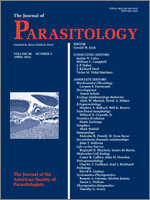Currently no comparative studies exist on helminth and leech community structure among sympatric anuran tadpoles and salamander larvae. During June–August 2007–2009, we examined 50 bullfrog tadpoles, Rana catesbeiana, 50 barred tiger salamander larvae, Ambystoma mavortium, and 3 species of snails from Nevens Pond, Keith County, Nebraska for helminth and leech infections. The helminth and leech compound community of this larval amphibian assemblage consisted of at least 7 species, 4 in bullfrog tadpoles and 4 in barred tiger salamander larvae. Bullfrog tadpoles were infected with 2 species of nematodes (Gyrinicola batrachiensis and Spiroxys sp.) and 2 types of metacercariae (Telorchis sp. and echinostomatids), whereas barred tiger salamander larva were infected with 1 species of leech (Placobdella picta), 2 species of adult trematodes (Telorchis corti and Halipegus sp.), and 1 species of an unidentified metacercaria. The component community of bullfrog tadpoles was dominated by helminths acquired through active penetration, or incidentally ingested through respiratory currents, or both, whereas the component community of larval salamanders was dominated by helminths acquired through ingestion of intermediate hosts (χ2 = 3,455.00, P < 0.00001). Differences in amphibian larval developmental time (2–3 yr for bullfrog tadpoles versus 2–5 mo for salamander larvae), the ephemeral nature of intermediate hosts in Nevens Pond, and the ability of bullfrog tadpole to eliminate echinostome infections had significant effects on mean helminth species richness among amphibian species and years (t = 12.31, P < 0.0001; t = 2.09, P = 0.04). Differences in herbivorous and carnivorous diet and time to metamorphosis among bullfrog tadpoles and barred tiger salamander larvae were important factors in structuring helminth communities among the larval stages of these 2 sympatric amphibian species, whereas size was important in structuring helminth and leech communities in larval salamanders, but not in bullfrog tadpoles.
BioOne.org will be down briefly for maintenance on 12 February 2025 between 18:00-21:00 Pacific Time US. We apologize for any inconvenience.
How to translate text using browser tools
1 April 2012
Helminth and Leech Community Structure in Tadpoles and Caudatan Larvae of Two Amphibian Species from Western Nebraska
Heather R. Rhoden,
Matthew G. Bolek
ACCESS THE FULL ARTICLE

Journal of Parasitology
Vol. 98 • No. 2
April 2012
Vol. 98 • No. 2
April 2012




